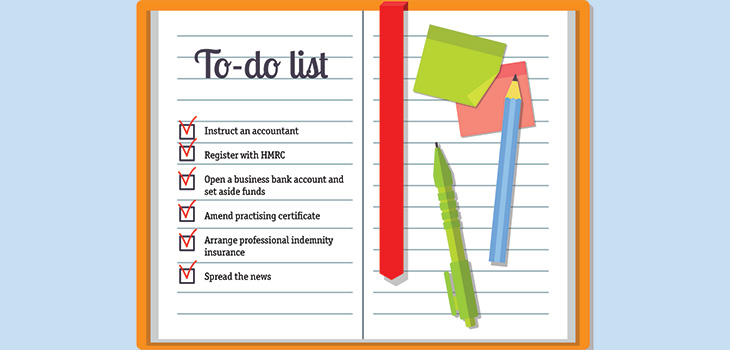*/

Lana Murphy and Francesca Perera started their careers at the Crown Prosecution Service before joining chambers. They discuss why they made the move and the practicalities of setting up self-employed practice as qualified juniors
There are pros and cons to both employed and self-employed practice. The advantages of being employed include a regular and predictable income, a pension contributed to by your employer, paid annual leave and sick pay etc. The benefits of being self-employed may include greater control over your practice, and faster career progression and development – the corollary of which may be the capacity to earn more.
Making the move from employed to self-employed can be a tough decision and a daunting prospect, especially when all you have ever known is the former. I undertook my pupillage at the Crown Prosecution Service (CPS) and, shortly after qualifying, was promoted to the role of Senior Crown Prosecutor.
With a year of practice under my belt, I took the leap and joined Chambers which was the right decision for both my practice and me. That is not to say this will be the perfect fit for everyone, and I am indebted to the CPS for the support and guidance I received.
Regrettably (and rather foolishly), as a pupil I had tuned out during the session run by Circuit which detailed the ins and outs of setting up a self-employed practice. This meant that when I made the decision to join Chambers, I was very much in the dark about what I needed to do.
Fortunately, Joseph Broadway (my co-pupil and a colleague at Albion Chambers) had already made the move and provided me with a ‘to-do’ list.
Finally, I would urge you to have conversations with other self-employed barristers – they are well-placed to answer any of your queries.
I started my career at the Crown Prosecution Service (CPS) where I completed pupillage, qualified and then remained there as an employed barrister in the role of Crown Prosecutor for around a year. As part of that role, I prepared and reviewed cases as well as prosecuting all types of hearings and cases in the Magistrates’ Court. The benefits and appeal of being an employed barrister are obvious: a regular and stable income, a good pension, annual leave and the ability to work flexibly. However, I was keen to have a Crown Court practice, and I also wanted to defend. To conduct Crown Court advocacy at the Crown Prosecution Service you have to be a Crown Advocate. The competition to become a Crown Advocate is high and there are relatively few roles. Therefore, towards the end of 2021 I started to consider a move to the self-employed Bar.
Before deciding whether or not to move I spoke to other self-employed barristers to obtain their advice on moving and how I could best prepare for the change. The advice that I received was broadly the same – there is a delay in receiving payment, there is no pension or annual leave but my career could develop faster and I would be exposed to more complex and challenging cases at the self-employed Bar.
In early 2022 I took the plunge and successfully applied for tenancy at No5 Chambers. Before leaving the CPS, I made sure that I had saved enough money to allow for the delay in payment and sought advice from an accountant. The change in the work I do has been significant. I now prosecute and defend in the Crown Court on a daily basis. I conduct trials for offences such as drugs, sexual offences and assault. I have been briefed as junior counsel for offences such as GBH with intent, firearms, drugs and murder. Alongside my crime practice I am also developing a regulatory practice. I know that the skills I developed while working at CPS have helped me in advancing my current practice.
Life at the self-employed Bar isn’t for everyone. You have to be prepared to adjust your work-life balance and to manage the variations in cashflow more carefully. There are also added complications that you don’t have when you’re employed, such as putting money aside for tax, VAT and a pension. You are essentially operating your own small business. But, after overcoming the initial worries about the uncertain world of self-employed practice, the positives far outweigh any negatives. I am so pleased that I moved to the self-employed Bar and while it is a personal decision for every barrister, I know that it was the right one for me.


There are pros and cons to both employed and self-employed practice. The advantages of being employed include a regular and predictable income, a pension contributed to by your employer, paid annual leave and sick pay etc. The benefits of being self-employed may include greater control over your practice, and faster career progression and development – the corollary of which may be the capacity to earn more.
Making the move from employed to self-employed can be a tough decision and a daunting prospect, especially when all you have ever known is the former. I undertook my pupillage at the Crown Prosecution Service (CPS) and, shortly after qualifying, was promoted to the role of Senior Crown Prosecutor.
With a year of practice under my belt, I took the leap and joined Chambers which was the right decision for both my practice and me. That is not to say this will be the perfect fit for everyone, and I am indebted to the CPS for the support and guidance I received.
Regrettably (and rather foolishly), as a pupil I had tuned out during the session run by Circuit which detailed the ins and outs of setting up a self-employed practice. This meant that when I made the decision to join Chambers, I was very much in the dark about what I needed to do.
Fortunately, Joseph Broadway (my co-pupil and a colleague at Albion Chambers) had already made the move and provided me with a ‘to-do’ list.
Finally, I would urge you to have conversations with other self-employed barristers – they are well-placed to answer any of your queries.
I started my career at the Crown Prosecution Service (CPS) where I completed pupillage, qualified and then remained there as an employed barrister in the role of Crown Prosecutor for around a year. As part of that role, I prepared and reviewed cases as well as prosecuting all types of hearings and cases in the Magistrates’ Court. The benefits and appeal of being an employed barrister are obvious: a regular and stable income, a good pension, annual leave and the ability to work flexibly. However, I was keen to have a Crown Court practice, and I also wanted to defend. To conduct Crown Court advocacy at the Crown Prosecution Service you have to be a Crown Advocate. The competition to become a Crown Advocate is high and there are relatively few roles. Therefore, towards the end of 2021 I started to consider a move to the self-employed Bar.
Before deciding whether or not to move I spoke to other self-employed barristers to obtain their advice on moving and how I could best prepare for the change. The advice that I received was broadly the same – there is a delay in receiving payment, there is no pension or annual leave but my career could develop faster and I would be exposed to more complex and challenging cases at the self-employed Bar.
In early 2022 I took the plunge and successfully applied for tenancy at No5 Chambers. Before leaving the CPS, I made sure that I had saved enough money to allow for the delay in payment and sought advice from an accountant. The change in the work I do has been significant. I now prosecute and defend in the Crown Court on a daily basis. I conduct trials for offences such as drugs, sexual offences and assault. I have been briefed as junior counsel for offences such as GBH with intent, firearms, drugs and murder. Alongside my crime practice I am also developing a regulatory practice. I know that the skills I developed while working at CPS have helped me in advancing my current practice.
Life at the self-employed Bar isn’t for everyone. You have to be prepared to adjust your work-life balance and to manage the variations in cashflow more carefully. There are also added complications that you don’t have when you’re employed, such as putting money aside for tax, VAT and a pension. You are essentially operating your own small business. But, after overcoming the initial worries about the uncertain world of self-employed practice, the positives far outweigh any negatives. I am so pleased that I moved to the self-employed Bar and while it is a personal decision for every barrister, I know that it was the right one for me.

Lana Murphy and Francesca Perera started their careers at the Crown Prosecution Service before joining chambers. They discuss why they made the move and the practicalities of setting up self-employed practice as qualified juniors


Chair of the Bar reflects on 2025
AlphaBiolabs has donated £500 to The Christie Charity through its Giving Back initiative, helping to support cancer care, treatment and research across Greater Manchester, Cheshire and further afield
Q&A with criminal barrister Nick Murphy, who moved to New Park Court Chambers on the North Eastern Circuit in search of a better work-life balance
Revolt Cycling in Holborn, London’s first sustainable fitness studio, invites barristers to join the revolution – turning pedal power into clean energy
Rachel Davenport, Co-founder and Director at AlphaBiolabs, reflects on how the company’s Giving Back ethos continues to make a difference to communities across the UK
By Marie Law, Director of Toxicology at AlphaBiolabs
Are you ready for the new way to do tax returns? David Southern KC explains the biggest change since HMRC launched self-assessment more than 30 years ago... and its impact on the Bar
Professor Dominic Regan and Seán Jones KC present their best buys for this holiday season
Marking one year since a Bar disciplinary tribunal dismissed all charges against her, Dr Charlotte Proudman discusses the experience, her formative years and next steps. Interview by Anthony Inglese CB
Little has changed since Burns v Burns . Cohabiting couples deserve better than to be left on the blasted heath with the existing witch’s brew for another four decades, argues Christopher Stirling
Pointillism, radical politics and social conscience. Review by Stephen Cragg KC